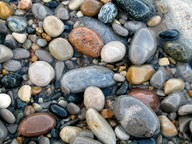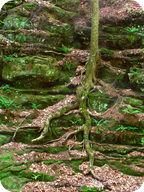13.2: Mechanical Weathering
- Page ID
- 5551
\( \newcommand{\vecs}[1]{\overset { \scriptstyle \rightharpoonup} {\mathbf{#1}} } \)
\( \newcommand{\vecd}[1]{\overset{-\!-\!\rightharpoonup}{\vphantom{a}\smash {#1}}} \)
\( \newcommand{\dsum}{\displaystyle\sum\limits} \)
\( \newcommand{\dint}{\displaystyle\int\limits} \)
\( \newcommand{\dlim}{\displaystyle\lim\limits} \)
\( \newcommand{\id}{\mathrm{id}}\) \( \newcommand{\Span}{\mathrm{span}}\)
( \newcommand{\kernel}{\mathrm{null}\,}\) \( \newcommand{\range}{\mathrm{range}\,}\)
\( \newcommand{\RealPart}{\mathrm{Re}}\) \( \newcommand{\ImaginaryPart}{\mathrm{Im}}\)
\( \newcommand{\Argument}{\mathrm{Arg}}\) \( \newcommand{\norm}[1]{\| #1 \|}\)
\( \newcommand{\inner}[2]{\langle #1, #2 \rangle}\)
\( \newcommand{\Span}{\mathrm{span}}\)
\( \newcommand{\id}{\mathrm{id}}\)
\( \newcommand{\Span}{\mathrm{span}}\)
\( \newcommand{\kernel}{\mathrm{null}\,}\)
\( \newcommand{\range}{\mathrm{range}\,}\)
\( \newcommand{\RealPart}{\mathrm{Re}}\)
\( \newcommand{\ImaginaryPart}{\mathrm{Im}}\)
\( \newcommand{\Argument}{\mathrm{Arg}}\)
\( \newcommand{\norm}[1]{\| #1 \|}\)
\( \newcommand{\inner}[2]{\langle #1, #2 \rangle}\)
\( \newcommand{\Span}{\mathrm{span}}\) \( \newcommand{\AA}{\unicode[.8,0]{x212B}}\)
\( \newcommand{\vectorA}[1]{\vec{#1}} % arrow\)
\( \newcommand{\vectorAt}[1]{\vec{\text{#1}}} % arrow\)
\( \newcommand{\vectorB}[1]{\overset { \scriptstyle \rightharpoonup} {\mathbf{#1}} } \)
\( \newcommand{\vectorC}[1]{\textbf{#1}} \)
\( \newcommand{\vectorD}[1]{\overrightarrow{#1}} \)
\( \newcommand{\vectorDt}[1]{\overrightarrow{\text{#1}}} \)
\( \newcommand{\vectE}[1]{\overset{-\!-\!\rightharpoonup}{\vphantom{a}\smash{\mathbf {#1}}}} \)
\( \newcommand{\vecs}[1]{\overset { \scriptstyle \rightharpoonup} {\mathbf{#1}} } \)
\( \newcommand{\vecd}[1]{\overset{-\!-\!\rightharpoonup}{\vphantom{a}\smash {#1}}} \)
\(\newcommand{\avec}{\mathbf a}\) \(\newcommand{\bvec}{\mathbf b}\) \(\newcommand{\cvec}{\mathbf c}\) \(\newcommand{\dvec}{\mathbf d}\) \(\newcommand{\dtil}{\widetilde{\mathbf d}}\) \(\newcommand{\evec}{\mathbf e}\) \(\newcommand{\fvec}{\mathbf f}\) \(\newcommand{\nvec}{\mathbf n}\) \(\newcommand{\pvec}{\mathbf p}\) \(\newcommand{\qvec}{\mathbf q}\) \(\newcommand{\svec}{\mathbf s}\) \(\newcommand{\tvec}{\mathbf t}\) \(\newcommand{\uvec}{\mathbf u}\) \(\newcommand{\vvec}{\mathbf v}\) \(\newcommand{\wvec}{\mathbf w}\) \(\newcommand{\xvec}{\mathbf x}\) \(\newcommand{\yvec}{\mathbf y}\) \(\newcommand{\zvec}{\mathbf z}\) \(\newcommand{\rvec}{\mathbf r}\) \(\newcommand{\mvec}{\mathbf m}\) \(\newcommand{\zerovec}{\mathbf 0}\) \(\newcommand{\onevec}{\mathbf 1}\) \(\newcommand{\real}{\mathbb R}\) \(\newcommand{\twovec}[2]{\left[\begin{array}{r}#1 \\ #2 \end{array}\right]}\) \(\newcommand{\ctwovec}[2]{\left[\begin{array}{c}#1 \\ #2 \end{array}\right]}\) \(\newcommand{\threevec}[3]{\left[\begin{array}{r}#1 \\ #2 \\ #3 \end{array}\right]}\) \(\newcommand{\cthreevec}[3]{\left[\begin{array}{c}#1 \\ #2 \\ #3 \end{array}\right]}\) \(\newcommand{\fourvec}[4]{\left[\begin{array}{r}#1 \\ #2 \\ #3 \\ #4 \end{array}\right]}\) \(\newcommand{\cfourvec}[4]{\left[\begin{array}{c}#1 \\ #2 \\ #3 \\ #4 \end{array}\right]}\) \(\newcommand{\fivevec}[5]{\left[\begin{array}{r}#1 \\ #2 \\ #3 \\ #4 \\ #5 \\ \end{array}\right]}\) \(\newcommand{\cfivevec}[5]{\left[\begin{array}{c}#1 \\ #2 \\ #3 \\ #4 \\ #5 \\ \end{array}\right]}\) \(\newcommand{\mattwo}[4]{\left[\begin{array}{rr}#1 \amp #2 \\ #3 \amp #4 \\ \end{array}\right]}\) \(\newcommand{\laspan}[1]{\text{Span}\{#1\}}\) \(\newcommand{\bcal}{\cal B}\) \(\newcommand{\ccal}{\cal C}\) \(\newcommand{\scal}{\cal S}\) \(\newcommand{\wcal}{\cal W}\) \(\newcommand{\ecal}{\cal E}\) \(\newcommand{\coords}[2]{\left\{#1\right\}_{#2}}\) \(\newcommand{\gray}[1]{\color{gray}{#1}}\) \(\newcommand{\lgray}[1]{\color{lightgray}{#1}}\) \(\newcommand{\rank}{\operatorname{rank}}\) \(\newcommand{\row}{\text{Row}}\) \(\newcommand{\col}{\text{Col}}\) \(\renewcommand{\row}{\text{Row}}\) \(\newcommand{\nul}{\text{Nul}}\) \(\newcommand{\var}{\text{Var}}\) \(\newcommand{\corr}{\text{corr}}\) \(\newcommand{\len}[1]{\left|#1\right|}\) \(\newcommand{\bbar}{\overline{\bvec}}\) \(\newcommand{\bhat}{\widehat{\bvec}}\) \(\newcommand{\bperp}{\bvec^\perp}\) \(\newcommand{\xhat}{\widehat{\xvec}}\) \(\newcommand{\vhat}{\widehat{\vvec}}\) \(\newcommand{\uhat}{\widehat{\uvec}}\) \(\newcommand{\what}{\widehat{\wvec}}\) \(\newcommand{\Sighat}{\widehat{\Sigma}}\) \(\newcommand{\lt}{<}\) \(\newcommand{\gt}{>}\) \(\newcommand{\amp}{&}\) \(\definecolor{fillinmathshade}{gray}{0.9}\)Why is mechanical weathering so important here?
The high mountains of the Sierra Nevada are made of granite. The climate is cold. Mechanical weathering dominates the weathering here. Can you find signs of mechanical weathering in the photo? Can you see evidence of chemical weathering in the photo? Why is mechanical weathering so much more important than chemical weathering here? How is mechanical weathering altering the landscape in the high Sierra?
Mechanical Weathering
Mechanical weathering breaks rock into smaller pieces. These smaller pieces are just like the bigger rock; they're just smaller! The rock has broken without changing its composition. The smaller pieces have the same minerals in the same proportions. You could use the expression “a chip off the old block“ to describe mechanical weathering! The main agents of mechanical weathering are water, ice, and wind.
Ice Wedging
Rocks can break apart into smaller pieces in many ways. Ice wedging is common where water goes above and below its freezing point (Figure below). This can happen in winter in the mid-latitudes or in colder climates in summer. Ice wedging is common in mountainous regions like the Sierra Nevada pictured above.
Diagram showing ice wedging.
This is how ice wedging works. When liquid water changes into solid ice, it increases in volume. You see this when you fill an ice cube tray with water and put it in the freezer. The ice cubes go to a higher level in the tray than the water. You also may have seen this if you put a can of soda into the freezer so that it cools down quickly. If you leave the can in the freezer too long, the liquid expands so much that it bends or pops the can. (For the record, water is very unusual. Most substances get smaller when they change from a liquid to a solid.)
Ice wedging happens because water expands as it goes from liquid to solid. When the temperature is warm, water works its way into cracks in rock. When the temperature cools below freezing, the water turns to ice and expands. The ice takes up more space. Over time, this wedges the rock apart. Ice wedging is very effective at weathering. You can find large piles of broken rock at the base of a slope. These rocks were broken up by ice wedging. Once loose, they tumbled down the slope.
Abrasion
Abrasion is another type of mechanical weathering. With abrasion, one rock bumps against another rock. Gravity causes abrasion as a rock tumbles down a slope. Moving water causes abrasion; it moves rocks so that they bump against one another (Figure below). Strong winds cause abrasion by blasting sand against rock surfaces. Finally, the ice in glaciers cause abrasion. Pieces of rock embedded in ice at the bottom of a glacier scrape against the rock below. If you have ever collected beach glass or pebbles from a stream, you have witnessed the work of abrasion.
Water flowing through river or beach cobbles causes them to hit each other. This contact causes abrasion, which makes the rocks round.
Plants and Animals in Mechanical Weathering
Sometimes plants or animals cause mechanical weathering. This can happen slowly. A plant’s roots grow into a crack in rock. As the roots grow larger, they wedge open the crack (Figure below). Burrowing animals can also cause weathering. By digging for food or creating a hole to live, in the animal may break apart rock.
The large roots of this tree can break apart rock. This is mechanical weathering.
Humans and Mechanical Weathering
Today, human beings do a lot of mechanical weathering whenever we dig or blast into rock. This is common when we build homes, roads, and subways, or quarry stone for construction or other uses.
Summary
- Mechanical weathering breaks down existing rocks and minerals.
- Mechanical weathering keeps the chemical makeup of materials the same.
- Ice wedging, abrasion, and some actions of living organisms and humans bring about mechanical weathering.
Review
- Describe the process of ice wedging. In what environment is ice wedging most likely to happen?
- Describe the process of abrasion.
- How do plants and animals cause mechanical weathering?
Explore More
Use this resource to answer the questions that follow.
- What is physical weathering?
- How do trees break down solid rock?
- What causes the most common type of physical weathering?
- What percent does water expand?
- How does water break apart a rock?





